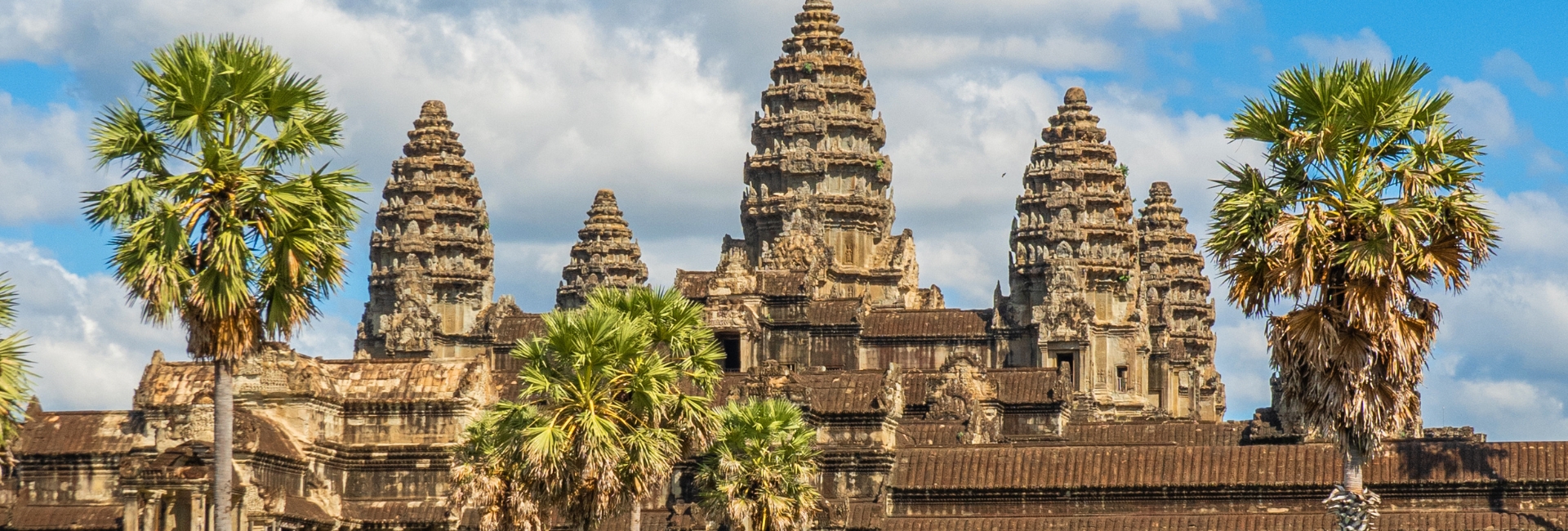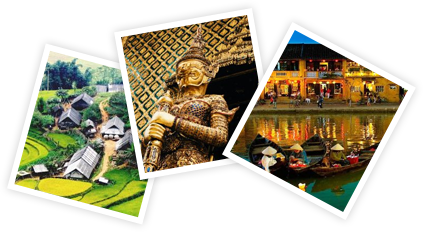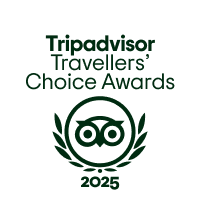Though Cambodia is not so popular in the region, this country is still a wonderful destination in Indochina. There are tons of attractions waiting for you to explore; from busy, bustling cities to small villages to wild jungles and stunning coastlines. This land is rich in culture, customs, and religion. This travel guide book to Cambodia is Indochina Voyages Team’s gift to be your comprehensive companion as you embark on an unforgettable journey through this beautiful country.
Quick Information about Cambodia
Nestled in Southeast Asia, Cambodia shares borders with Thailand, Laos, and Vietnam, with a captivating coastline along the Gulf of Thailand. Covering 181,035 square kilometers, it boasts diverse landscapes, from pristine southern beaches to lush forests and the mighty Mekong River.
The terrain of Cambodia is diverse, encompassing everything from plains and lowlands to mountains and coastlines, like the Cardamom Range, and serene coastlines. The Tonle Sap, Southeast Asia’s largest lake, sustains local communities. With natural wonders like the Cardamom Mountains and the Mondulkiri and Ratanakiri provinces’ lush landscapes, Cambodia offers eco-tourism opportunities and scenic beauty for travelers around the world when coming.
The population of Cambodia is approximately 16 million people, predominantly Khmer, with small communities of Cham, Vietnamese, Chinese, and other ethnic groups adding to the country’s cultural diversity. The warmth and hospitality of the Cambodian people, known for their resilience and friendliness, contribute to the country’s allure for travelers seeking authentic cultural experiences.
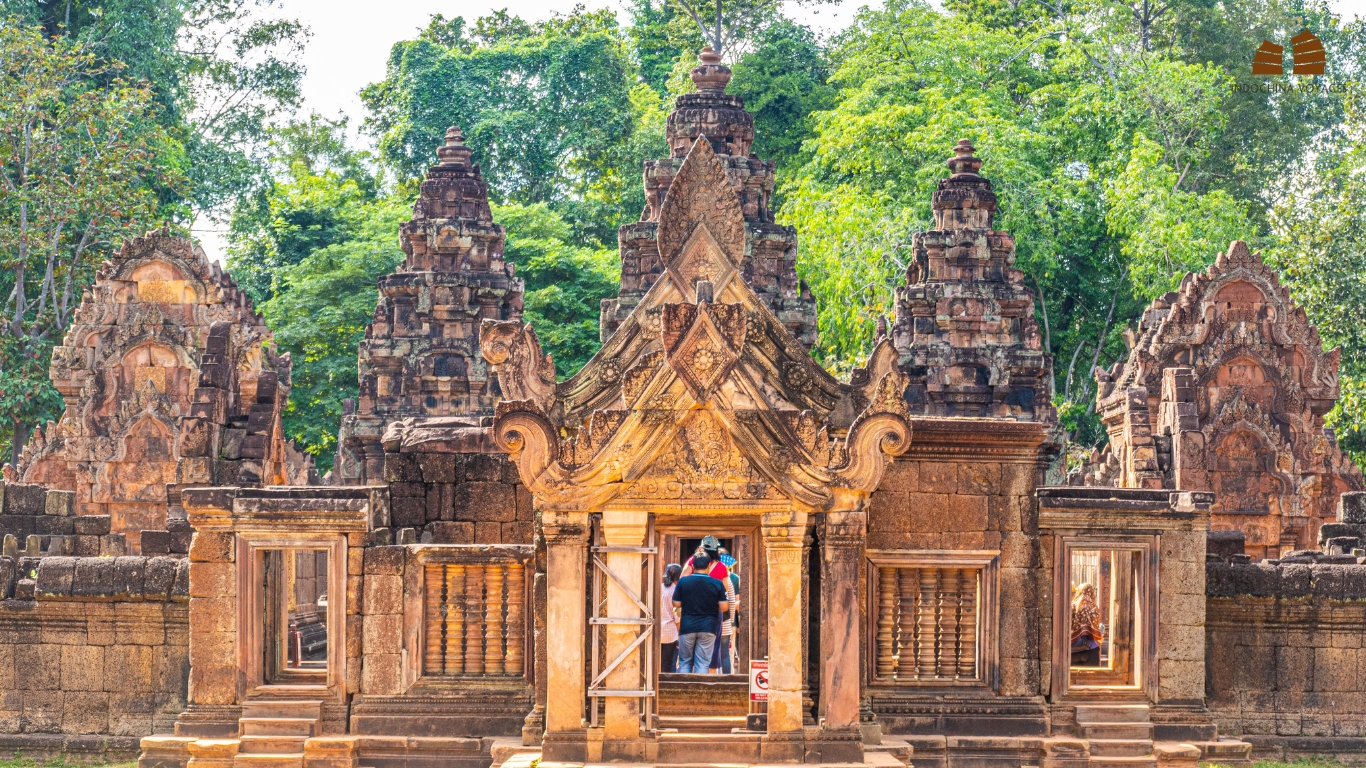
Must-visit Destinations
From the ancient allure of Angkor Wat to the serene coastlines of Kep, you can explore Cambodia’s destinations to wake up all your senses with a tapestry of historical wonders and natural beauty.
Phnom Penh
The first destination that cannot be mentioned when coming to Cambodia is the capital of this country, Phnom Penh. This city is a blend of modernity and tradition and also owns the main international airport of Cambodia, the Phnom Penh International Airport (PNH). Explore the Royal Palace, visit the haunting yet important Tuol Sleng Genocide Museum, and witness the lively markets along the Mekong River.
What can you expect in Phnom Penh?
- Historical Marvels: Visit the Royal Palace, Silver Pagoda, Tuol Sleng Genocide Museum, and the Killing Fields.
- Riverside Charms: Explore the Mekong River, Central Market, and the Night Market.
- Local Flavors: Indulge in Fish Amok and Khmer Red Curry.
- Cruise Experience: Enjoy a sunset cruise along the Tonle Sap River
- Spiritual Encounters: Discover Wat Phnom and Wat Ounalom for their cultural and spiritual significance.
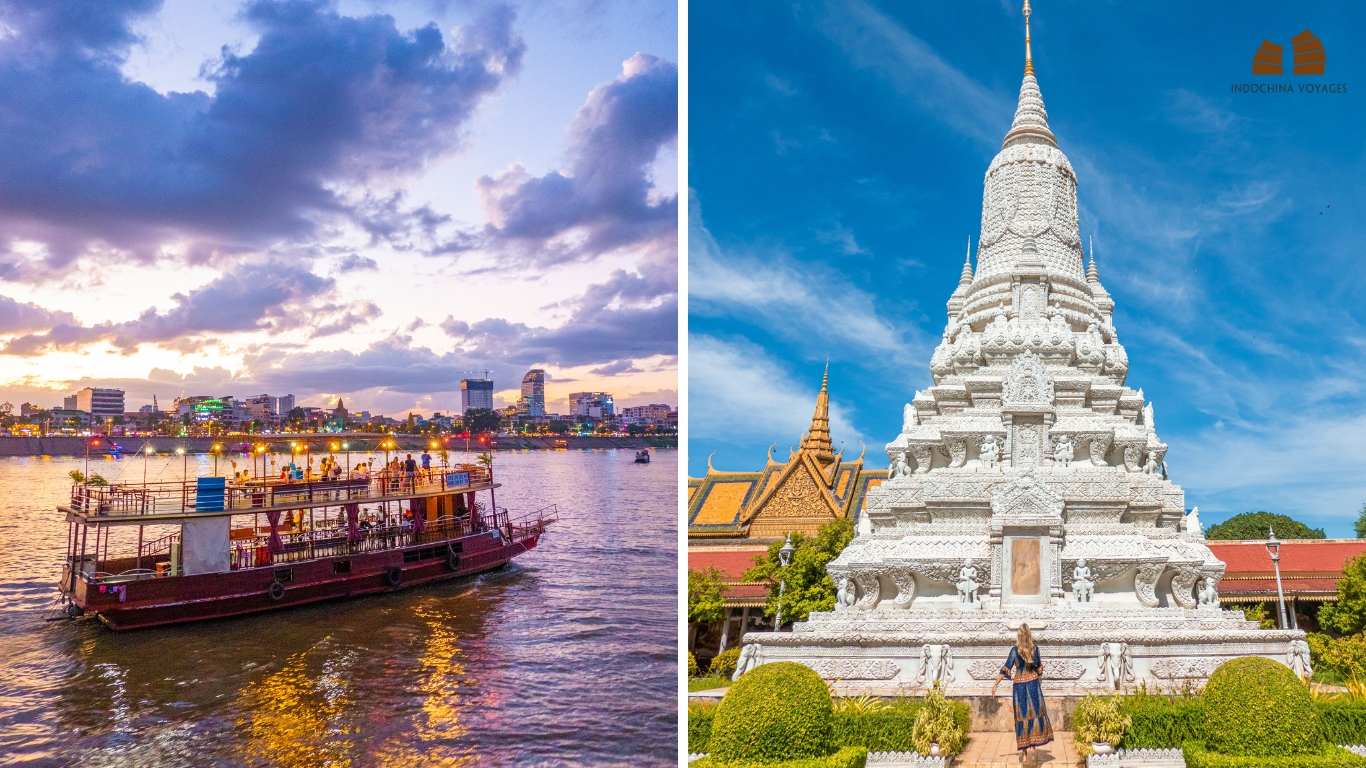
Siem Reap
As known as home to the renowned Angkor Archaeological Park, Siem Reap is a treasure trove of ancient temples including the iconic Angkor Wat. Don’t miss the chance to witness the sunrise over these breathtaking structures. Besides, visiting the fishing village while exploring Tonle Sap also is one of the most identicality experiences when talking about Siem Reap.
Additionally, there’s also the Siem Reap International Airport (REP) serving Siem Reap, which is another significant international entry point for tourists visiting Cambodia, especially to explore the Angkor Wat temples.
What can you expect in Seam Reap?
- Ancient Wonders: Explore the awe-inspiring Angkor Archaeological Park, home to iconic temples like Angkor Wat, Bayon, and Ta Prohm.
- Cultural Immersion: Engage in Apsara dance performances and traditional Cambodian activities at cultural villages.
- Local Markets: Discover vibrant markets like Psar Chas (Old Market) for authentic Cambodian souvenirs and street food.
- Adventure: Embark on activities like hot air balloon rides or zip-lining at the Angkor Archaeological Park.
- Culinary Delights: Experience Khmer cuisine through cooking classes or dining at local restaurants.
- Relaxation: Unwind in Siem Reap’s spas or enjoy a peaceful sunset at serene spots like Srah Srang.
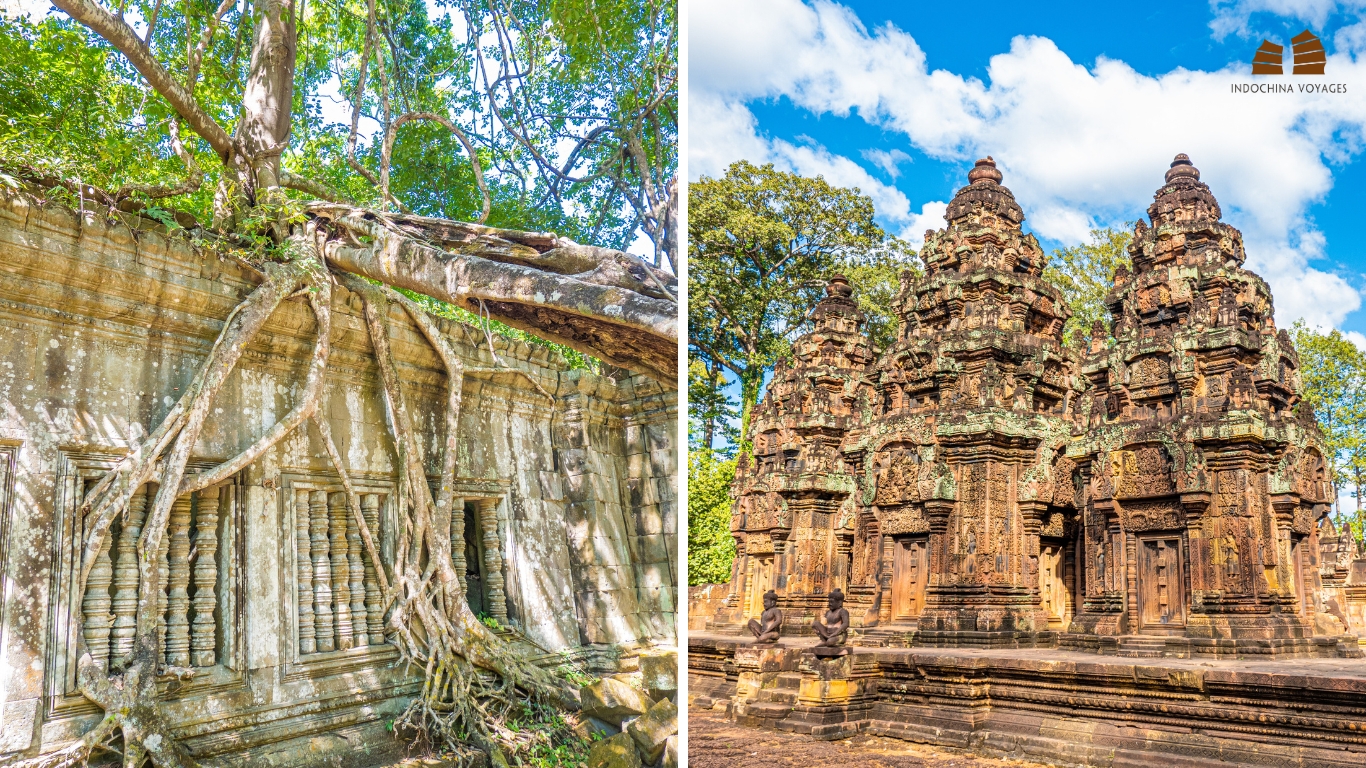
Kampong Cham
Kampong Cham, nestled along the banks of the mighty Mekong River, offers a serene escape with its charming blend of rural landscapes and cultural sites. Discover the bamboo bridge, explore Wat Nokor, and take in the laid-back atmosphere.
What can you expect in Kampong Cham?
- Cultural Gems: Discover the ancient Wat Nokor temple and explore the unique blend of Khmer and Angkorian architecture.
- Rural Serenity: Experience the tranquil island life of Koh Paen, accessed by the seasonal bamboo bridge, offering insights into local crafts and daily routines.
- Scenic Vistas: Ascend Phnom Srey and Phnom Pros for panoramic views overlooking the Mekong River and the picturesque countryside.
- Colonial Charms: Wander through streets adorned with remnants of French colonial architecture, immersing yourself in the town’s relaxed atmosphere.
- Active Exploration: Engage in leisurely bicycle tours around town and the countryside or opt for a serene Mekong River cruise.
- Market Discoveries: Delve into the bustling local markets like Kampong Cham Market, sampling fresh produce and experiencing the vibrant local culture.
KEP (Kampot)
Kampot, or KEP, invites travelers to immerse themselves in a serene and culturally rich atmosphere, where time slows down, allowing for a deeper connection with Cambodia’s natural beauty and historical legacy. Indulge in fresh seafood in Kep Crab Market, explore the lush Kep National Park, and unwind on the tranquil beaches, Kep is ideal for a relaxing coastal retreat.
What can you expect in KEP?
- Bokor National Park: Explore this expansive park featuring lush rainforests, waterfalls, and wildlife. Don’t forget to embark on hiking adventures with the summit offering panoramic views of the coast.
- Kampot Pepper Farms: Visit pepper plantations to learn about and sample Kampot’s renowned peppercorns, known for their unique flavor and quality.
- Riverside Promenade: Enjoy the relaxed vibe along the Preaek Tuek Chhu River, lined with cafes, restaurants, and guesthouses.
- Colonial Architecture: Stroll through the town to admire well-preserved colonial-era buildings, showcasing Kampot’s historical charm.
- Salt Fields: Witness the traditional salt production process at the salt fields, where locals gather salt from the evaporation ponds.
- Caves and Caves Temples: Explore caves like Phnom Chhnork, which houses ancient temples, and the mystical limestone formations of Kampong Trach.
- With its tranquil atmosphere, KEP is a wonderful place for taking a leisurely boat ride along the river, especially during sunset, for breathtaking views and a serene experience.
Battambang
As Cambodia’s second-largest city, Battambang offers travelers a blend of cultural experiences, architectural wonders, and natural beauty. The town’s blend of heritage, countryside beauty, and artistic endeavors ensures a memorable journey for travelers seeking authentic Cambodian experiences.
What can you expect in Battambang?
- Colonial Architecture: Wander through the town’s streets adorned with well-preserved French colonial buildings, showcasing the town’s historical significance.
- Bamboo Train (Norry): Experience the unique Bamboo Train, a local mode of transport riding on a bamboo platform propelled by a small engine. It’s an exhilarating way to explore the countryside.
- Phare Ponleu Selpak: Visit this renowned non-profit arts school where students display their talents in visual arts, circus performances, and more, showcasing Cambodia’s vibrant art scene.
- Ancient Temples and Pagodas: Explore temples like Wat Banan and Wat Ek Phnom, featuring ancient Khmer architecture and intricate carvings.
- Battambang Circus: Attend a performance at Phare Ponleu Selpak’s circus, known for its high-energy and artistic acrobatics, providing entertainment while supporting a social cause.
- Countryside Bike Tours: Discover the rural charm of Battambang by cycling through picturesque villages, rice fields, and local markets, immersing yourself in the region’s agricultural life.
- Battambang Provincial Museum: Delve into the town’s history at the museum, showcasing artifacts and exhibits that shed light on Battambang’s cultural heritage.
- Phnom Sampov: Visit this hill offering panoramic views and explore the Killing Caves, a stark reminder of Cambodia’s tragic past.
- Local Markets: Dive into bustling markets like Psar Nat and Psar Boeung Chhouk, where you can experience the local lifestyle and shop for traditional crafts and local produce.
- Rice Paper and Rice Wine Production: Witness the traditional process of making rice paper and sampling local rice wine, offering insights into Cambodia’s culinary heritage.
Other Off-the-beaten-path Destinations
Besides vibrant spots which attract tourists when come to Cambodia, this country also boasts several off-the-beaten-path destinations that offer unique experiences away from the typical tourist spots. Here are a few for your reference:
- Chi Phat: Tucked within the Cardamom Mountains, this community-based ecotourism site offers immersive experiences in nature. Visitors can engage in trekking, wildlife spotting, and homestays with local families, contributing to sustainable tourism efforts.
- Koh Ker: This remote archaeological site, once the capital of the Khmer Empire, is adorned with ancient temples and ruins. Its distance from Siem Reap (approximately 120 kilometers (about 75 miles)) makes it less frequented, allowing for a quieter exploration of this historically significant area.
- Koh S’dach: Off the coast of Koh Kong province, this island remains relatively undiscovered. Its pristine beaches, fishing communities, and serene atmosphere provide an off-the-grid experience for travelers seeking tranquility.
- Kampong Thom Province: While Sambor Prei Kuk receives some attention, venturing further into Kampong Thom province reveals hidden villages, serene landscapes, and lesser-explored temple ruins, offering a quieter alternative to the more popular sites.
- Koh Thmei: Situated within Ream National Park near Sihanoukville, Koh Thmei is a secluded island with minimal development. Visitors can enjoy pristine beaches, mangrove forests, and excellent birdwatching opportunities.
- Kep Archipelago (Koh Tonsay): While Kep itself is gaining attention, its nearby islands, especially Koh Tonsay (Rabbit Island), remain relatively untouched. Rustic bungalows, quiet beaches, and a slow-paced atmosphere characterize this island getaway.
Best time to visit Cambodia Weather
Cambodia generally experiences a tropical monsoon climate characterized by distinct wet and dry seasons:
- Wet Season (May to October): This period brings heavy rainfall, particularly from June to September. The wet season sees high humidity and frequent downpours, which can sometimes lead to flooding in certain regions. Temperatures remain warm, usually ranging from 25°C to 35°C (77°F to 95°F).
- Dry Season (November to April): This season is marked by drier and cooler weather. November to February is cooler with temperatures averaging around 20°C to 30°C (68°F to 86°F). March and April are the hottest months, with temperatures often exceeding 35°C (95°F).
Here are some Best times to visit Cambodia Weather you should know:
- Best time for Sightseeing and Temples (Angkor Wat, Siem Reap): November to February for cooler, dry weather.
- Best time for Beach and Coastal Areas (Sihanoukville, Koh Rong): November to April for sunny days and beach activities.
- Countryside Exploration (Battambang, Kampot): Dry season (November to April) for easier exploration, wet season for lush landscapes (May to October).
- Wildlife and Nature (Mondulkiri, Ratanakiri): Dry season (November to April) for wildlife spotting and accessible trails.
- Cultural Festivals: Time your visit during festivals like Khmer New Year (April), Water Festival (November), or Bon Om Touk (October/November) for cultural experiences.
- Avoiding Crowds and Budget Travel: Consider the shoulder seasons (May to October) for fewer tourists and possible discounts, but expect occasional heavy rains.
Inspiration Cambodia
Experience a tapestry of vibrant culture, resilient history, tantalizing cuisine, and spiritual richness as Cambodia beckons travelers with its awe-inspiring temples, warm hospitality, and a delectable array of Khmer flavors waiting to be savored.
Art & Culture
Cambodia’s cultural canvas paints a mesmerizing portrait, adorned with the intricate carvings of Angkor’s temples, the graceful movements of traditional Apsara dance, and the vivid hues of bustling markets, each stroke revealing a story of resilience, artistry, and spiritual depth. When coming to explore the vibrant Art&Culture.
Khmer Architecture and Temples
Explore the rich architectural legacy of the Khmer Empire, focusing on iconic structures like Angkor Wat, Bayon Temple, and Ta Prohm. Dive into the intricacies of bas-reliefs, symbolic motifs, and the spiritual significance embedded in these ancient marvels.
Khmer architecture and temples in Cambodia exhibit several outstanding features that define their unique style and grandeur that you can explore:
- Tower Temples and Central Sanctuaries: Khmer temples are characterized by towering structures, often featuring multiple levels and galleries leading to a central sanctuary. Prominent examples include the majestic spires of Angkor Wat and the enigmatic Bayon Temple.
- Bas-Reliefs and Carvings: Elaborate bas-reliefs and intricate carvings adorn temple walls, depicting epic Hindu myths, historical events, and scenes from everyday life. The carvings at Angkor Wat and Banteay Srei are renowned for their detail and artistry.
- Gopuras and Entrance Gates: Impressive entrance gates or gopuras, featuring intricately carved facades and multi-tiered roofs, serve as grand entryways to temple complexes, such as the South Gate of Angkor Thom.
- Baray (Reservoirs) and Water Management: Some temples, like Angkor Wat, are surrounded by vast reservoirs (baray) that served as crucial elements of ancient Khmer water management, symbolizing cosmic oceans.
- Lateral Galleries and Libraries: Temples often have lateral galleries featuring columns, libraries, and pavilions, providing additional space for religious ceremonies, sculptures, and scriptures.
- Symmetry and Alignment: Khmer architecture showcases a remarkable sense of symmetry and precision, with many structures aligned along cardinal points and following intricate geometric designs.
- Lotus Bud Towers: The towers atop Khmer temples are often designed in the shape of lotus buds, symbolizing purity and divinity.
- Integration of Hindu and Buddhist Elements: While initially Hindu temples were dedicated to deities like Shiva and Vishnu, many temples later adopted Buddhist elements, showcasing the evolution of Khmer religious beliefs
Traditional Arts and Performing Arts
The vibrant Art&Culture canvas in Cambodia is also expressed through wonderful traditional performances. Delve into Cambodia’s traditional arts scene, including Apsara dance, shadow puppetry (Sbek Thom), and classical music (Pinpeat orchestra). Learn about the historical context, stories behind performances, and where to witness these art forms.
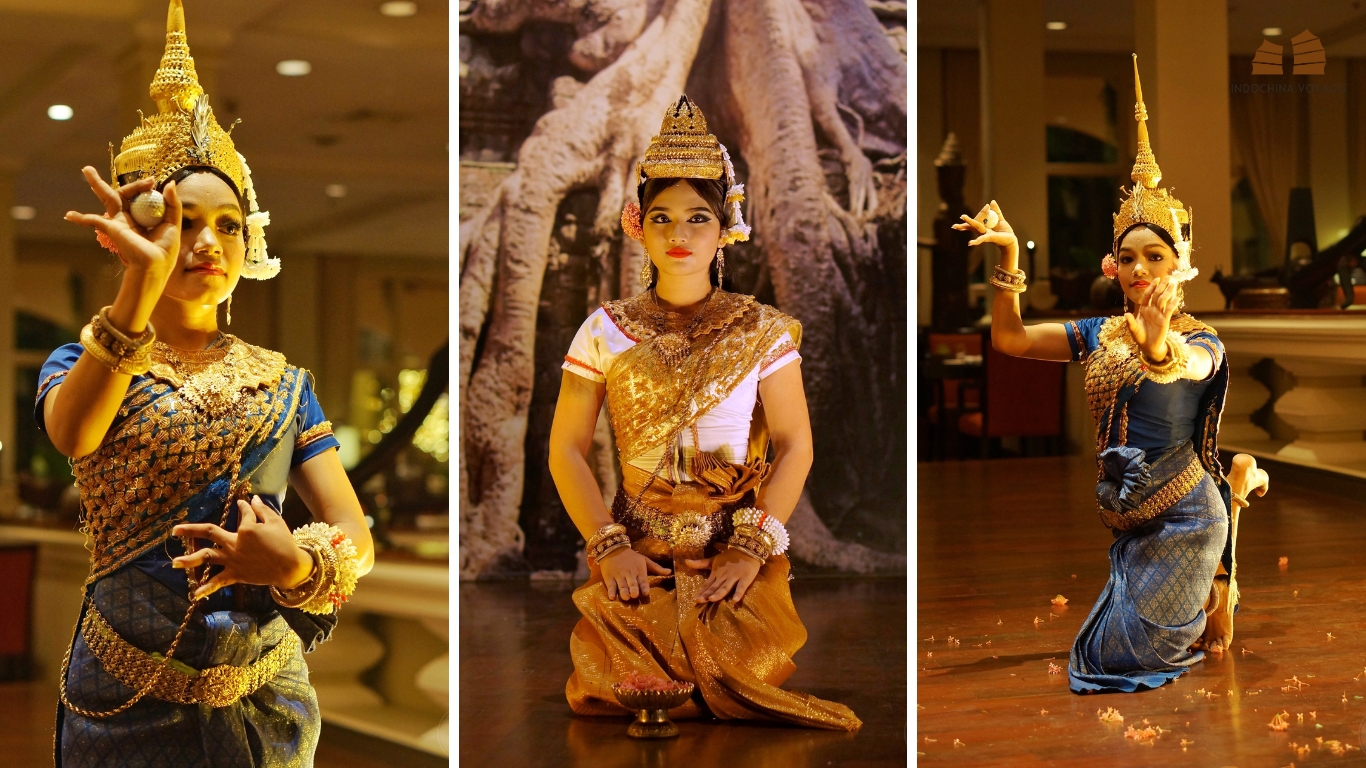
Cultural Festivals and Celebrations
Cambodians are also common with their significant festivals such as Khmer New Year (Choul Chnam Thmey), Water Festival (Bon Om Touk), and Pchum Ben (Ancestor’s Day). Cambodia’s vibrant festival scene offers travelers a rich tapestry of cultural immersion and memorable experiences, each celebration showcasing the country’s heritage, spirituality, and community bonds.
So what can you expect in these vibrant festivals?
- Cultural Diversity: Cambodia’s festivals blend ancient beliefs with modern celebrations, showcasing Hindu, Buddhist, and animist traditions.
- Colorful Celebrations: Vibrant processions, dance, and music create captivating spectacles at festivals.
- Community Togetherness: Festivals foster unity, inviting travelers to join locals in dances, ceremonies, and rituals.
- Symbolism and Rituals: Water, fire, and offerings hold symbolic meanings, representing purification, renewal, and gratitude.
- Various Locations: Celebrations occur countrywide, from city streets to rural pagodas, offering authentic experiences.
- Year-round Highlights: Each festival, from Khmer New Year to Pchum Ben, unveils unique facets of Cambodia’s heritage.
- Cultural Immersion: Engaging in these celebrations allows travelers to forge connections and deepen their understanding of Cambodian traditions.
- Authentic Memories: Participating in festivals offers genuine encounters, creating lasting memories steeped in Cambodia’s cultural richness.
Religious Practices and Spiritual Sites
Theravada Buddhism plays a pivotal role in Cambodian society, influencing customs, traditions, and values. Respect for monks, devotion to temples, and merit-making rituals are integral parts of daily life.
When coming to Cambodia, don’t forget to catch the opportunities that offer an understanding of Theravada Buddhism, the predominant religion in Cambodia, and its influence on daily life. Guide readers on temple etiquette, and meditation practices, and recommend spiritual sites for a serene and reflective experience.
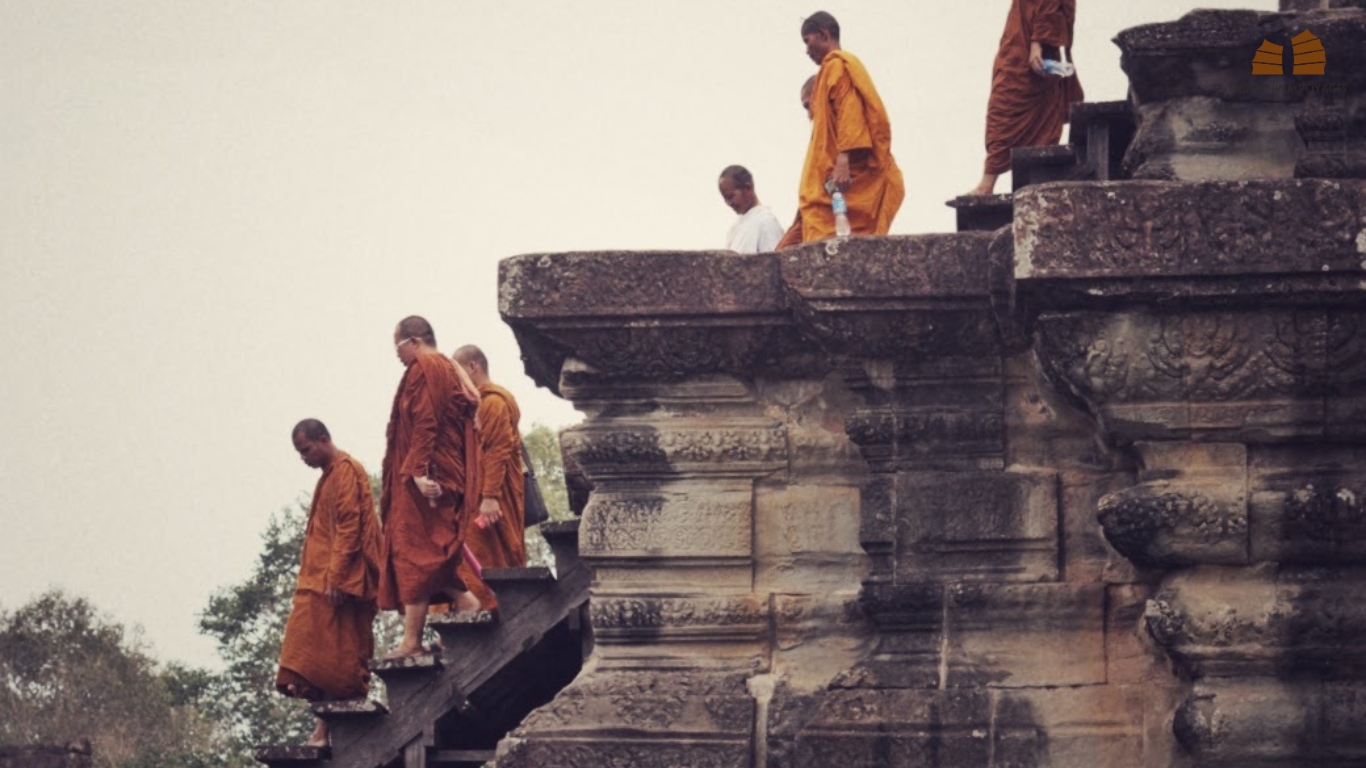
Craftsmanship and Handicrafts
Immersing yourself in Cambodia’s vibrant artisanal scene unveils a world of intricate craftsmanship, centuries-old techniques, and artistic finesse, offering travelers a chance to witness the country’s creative legacy firsthand.
What can you expect when exploring Craftsmanship and Handicrafts in Cambodia?
- Silk Weaving: Explore traditional silk weaving in villages like Takeo or Siem Reap’s Artisans Angkor silk farm.
- Pottery Villages: Visit Kampong Chhnang to witness skilled artisans molding clay into exquisite pottery.
- Silverware Artistry: Discover the intricate craft of silver jewelry in places like the Pouk district.
- Artisan Workshops: Engage with local communities and workshops to learn techniques and appreciate craftsmanship.
- Vibrant Markets: Psar Chaa in Siem Reap and Psar Leu in Sihanoukville offer handmade crafts and souvenirs.
- Cultural Heritage: Support artisans to preserve Cambodia’s rich artistic traditions and cultural heritage.
- Artistic Encounters: Join workshops or craft classes offered by organizations like Artisans Angkor for hands-on experiences.
Food & Cuisine
Cambodian cuisine is similar to Thai, but it uses fewer spices and tends to be healthier. Their staple food is rice and noodles. Normally a Cambodian meal consists of a soup, a main dish which is usually curry, stir-fry or salad, and dessert.
Some of the most common and must-try dishes are:
- Bai Sach Chrouk with pork and rice
- Fish Amok – a type of curry
- Lap Khmer – lime-marinated beef salad
- Nom Banh Chok – Khmer noodles and Red Curry
- Finally, don’t forget all the tasty fruits in this land.
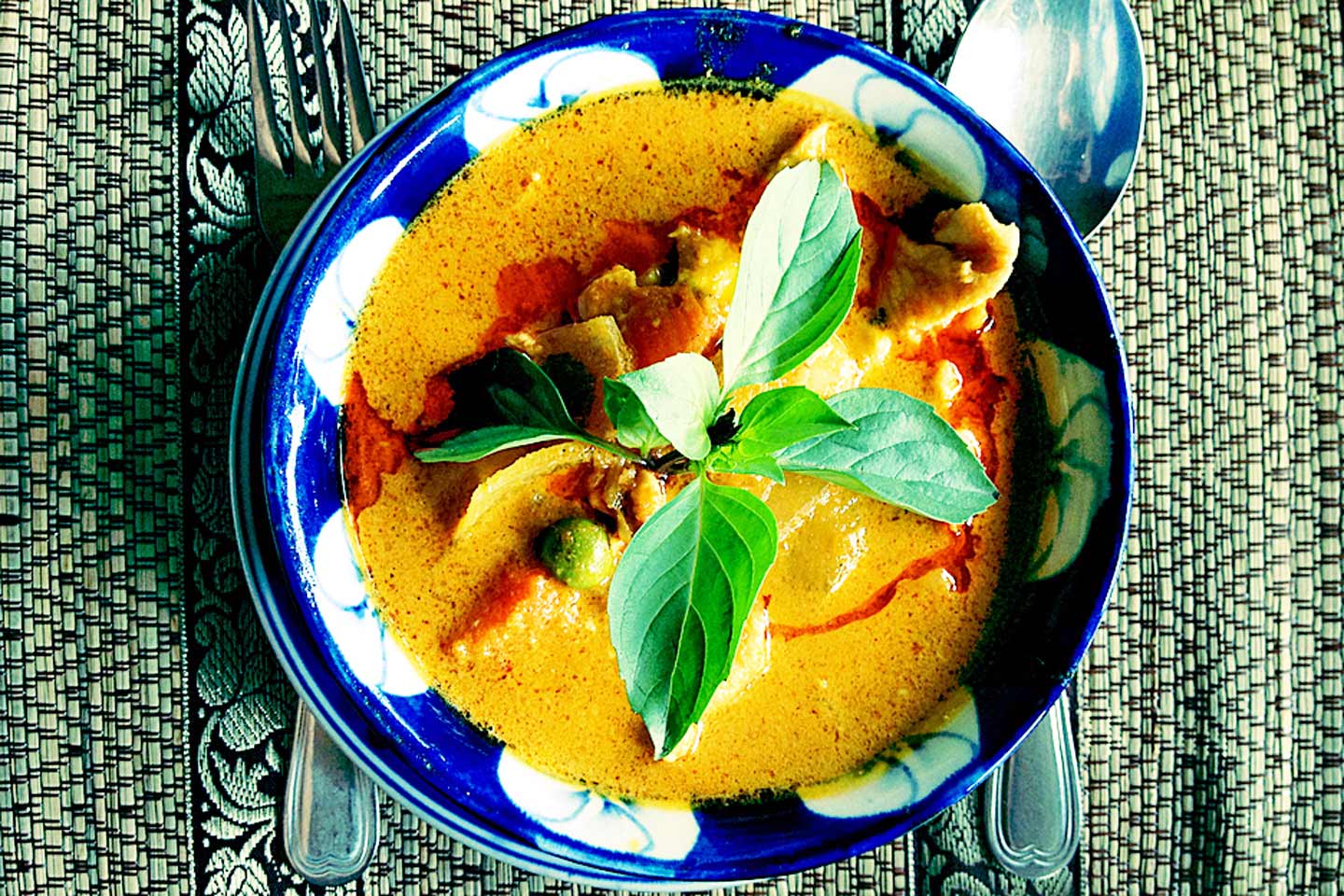
Must-Read Cambodia Package List Information for All Travelers
For travelers visiting Cambodia, essential package list information encompasses visa details, currency essentials, language considerations, and cultural etiquette for a seamless and enriching experience.
Visa
Cambodia Visa will have two categories: tourism and trade, as follows:
- Cambodia tourist visa duration: Will be 1 month for 1 entry, and allowed to stay 30 days.
- Commercial visa duration: There will be a period of 3 months for 1 or more entries into the Kingdom of Cambodia.
According to the policy prescribed by Cambodia, if you come on the list below can be exempted from a visa for 14-30 days: Thailand (14 days), Philippines (21 days), Vietnam, Indonesia, Laos, Malaysia, and Singapore (30 days).
There are two ways to apply for Cambodia Visa:
E-Visa
An electronic visa (e-visa) is only available for travel purposes with a duration of up to 1 month (30 days) within the country and permits a single entry. To acquire the e-visa, there is a fee of approximately USD $37 that needs to be paid during the application process.
Note: E-visa does not apply to citizens of the following countries: Saudi Arabia, Sri Lanka, Sudan Afghanistan, Algeria, Bangladesh, Iran, Iraq, Nigeria, and Pakistan.
Apply at the international border gate
Visas applied for at international border gates will be issued for the purpose of tourism or business in Cambodia with a maximum stay is about 1 month (30 days) and permits a single entry. Besides, you are also allowed to extend it. The fee when applying visa at the international border gate is about USD $35.
What to Bring with Cambodia Electricity?
The standard voltage is 230V and the plug type is usually Type A, C, or G. When traveling to Cambodia, it’s advisable to bring:
- Universal plug adapters compatible with type A, C, and G sockets.
- Check the voltage compatibility of your devices and bring voltage converters if necessary.
- Consider carrying a portable charger or power bank for backup power.
Currency and Available Payment
Cambodia uses the Cambodian Riel (KHR) as its official currency, but US dollars (USD) are widely accepted, especially in tourist areas. You should exchange money at banks, official counters, or authorized changers. Both USD and Riel are commonly used.
ATMs are available in cities, dispensing both currencies. Credit cards are accepted in larger establishments but carrying cash for smaller shops and markets is a high recommendation.
Available Language
Khmer is the official language, but English is widely spoken in tourist areas, hotels, and by younger locals. Basic Khmer phrases can enhance interactions, but English suffices in most tourist spots. French and Chinese might be understood in specific areas due to historical connections or trade.
Some necessary etiquette
- Cambodia is a highly religious country, with the dominance of Buddhism. It’s okay if the visitors are not familiar with the local customs, but you should always be respectful. One thing to remember is you must dress appropriately when visiting the religious sites, with your legs and shoulders covered.
- Also, remember to remove your shoes and hats before entering a temple.
- Refrain yourself from shouting, or acting aggressively, because to their culture, “losing one’s cool” in public is completely unacceptable.
- Always be kind and polite to people, especially the elders and the monks. Never bring up sensitive subjects such as war, violence, or the Khmer Rouge.
FAQs
Is Cambodia safe for travelers?
Overall, Cambodia can be a safe destination for travelers with proper precautions, but with sensible precautions, it can be a safe destination. Here are Safety Highlights in Cambodia:
- Crime: Petty crime like pickpocketing and bag snatching can occur, especially in crowded areas and tourist spots. Keeping belongings secure and being vigilant in crowded places is advisable.
- Scams: Tourist-targeted scams exist, such as overcharging or misrepresentation of prices. Be cautious and confirm prices before making purchases or hiring services.
- Traffic: Road safety can be a concern due to erratic driving behaviors, especially in urban areas. Exercise caution when crossing roads and consider using reputable transportation options.
- Health and Hygiene: Like in many tropical countries, certain health issues like mosquito-borne diseases (such as dengue fever) can be a concern. Using mosquito repellent and taking necessary vaccinations before travel is recommended.
- Landmines: In rural areas and along the borders, unexploded landmines from past conflicts may still pose a risk. Stay on well-traveled paths and avoid venturing into unknown areas without a local guide.
Do US citizens need a visa for cambodia?
Yes, US citizens planning to visit Cambodia for tourism or business purposes need a visa to enter the country. There are a few options for obtaining a visa:
- Visa on Arrival: US citizens can obtain a visa upon arrival at the international airports in Phnom Penh, Siem Reap, and certain land borders. This visa allows for a stay of up to 30 days.
- E-Visa: Another option is to apply for an e-visa before arrival through the Cambodian Ministry of Foreign Affairs’ official website. This allows for a single-entry visit of up to 30 days and is available for tourism purposes only.
- Cambodian Embassy or Consulate: US citizens can also apply for a visa at the Cambodian Embassy or Consulate in the United States before their trip.
What are the transportation options in Cambodia?
Cambodia offers various transportation options for travelers, ranging from traditional to modern modes. Here are the main ones:
- Tuk-Tuks: These three-wheeled vehicles are a popular and inexpensive way to get around cities and towns. They’re commonly used for short distances and offer a convenient way to navigate through traffic.
- Motorbike Taxis (Motodops): Motorbike taxis are prevalent in urban areas. They’re useful for short trips and navigating through crowded streets, offering a quick way to get around.
- Taxis: Metered taxis are available in larger cities like Phnom Penh and Siem Reap. However, in some cases, negotiating fares beforehand might be necessary, especially for trips outside the city.
- Rental Cars and Motorbikes: Renting a car or motorbike is an option, especially for travelers who prefer more independence in exploring the country. However, driving in Cambodia can be challenging due to traffic and road conditions, so caution is advised.
- Buses: Cambodia has an extensive network of buses connecting major cities and towns. From basic to more luxurious options, buses are a popular choice for both short and long-distance travel. Companies like Giant Ibis and Mekong Express offer comfortable services between major destinations.
- Boats: In regions with waterways like the Tonle Sap or along the Mekong River, boats are used as a means of transportation, especially for reaching more remote areas or for scenic tours.
- Trains: While the rail network is limited in Cambodia, trains connect a few key destinations, such as Phnom Penh to Sihanoukville and Kampot. The service might be less frequent and slower compared to other modes of transportation.
- Domestic Flights: For longer distances, domestic flights can be an option. Cambodia has several airports connecting major cities like Siem Reap, Phnom Penh, and Sihanoukville.
How many days do you need to see Cambodia?
The ideal duration for a trip to Cambodia can vary based on individual preferences, the places you want to visit, and the depth of exploration. For a comprehensive visit covering major highlights, plan around 7-10 days. A more relaxed exploration might take 10-14 days or longer to immerse in different areas of Cambodia.
Suggested Cambodia Tours
If you’re planning a trip to Cambodia, it’s essential to have a well-planned itinerary to have a lifetime experience. However, it can be challenging to navigate a new place without a guide. That’s why you should connect with local guides who can bring you insider knowledge and make your experience much more memorable.
Cambodia is a splendid and spectacular destination with beautiful nature and rich cultural heritage. Follow our guide to have a remarkable experience during Cambodia Tours.
IV Travel Specialist

